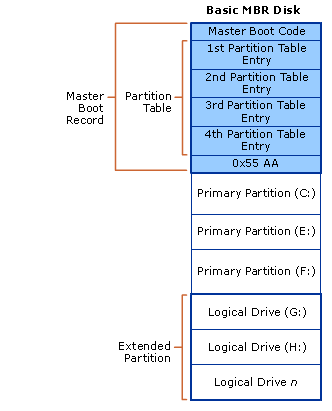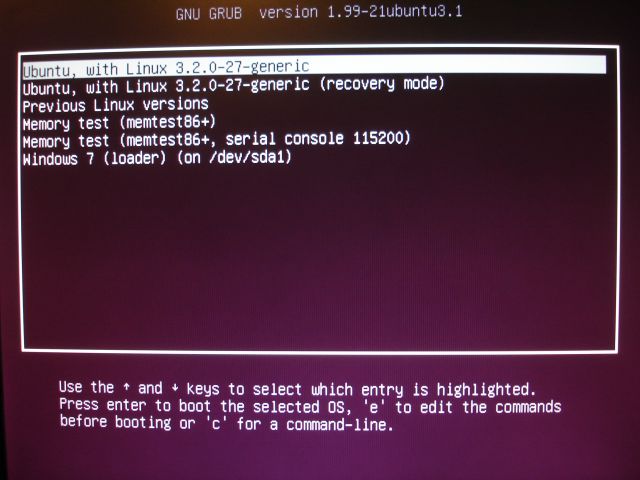What Happens When You Power On Your Computer
Feb 7, 2014 00:00 · 1060 words · 5 minute read
Ever wondered what all goes inside your computer when you switch on the power button? How is an Operating System loaded ? How you are presented with an user friendly GUI screen? Through this post I will peek into the booting process of UNIX like Operating Systems and try to answer some of the questions. Some of the things discussed in this post are also valid for Windows operating system.
An overview of the boot process

When the computer is switched on, it’s of no use because the data stored in the memory(RAM) is garbage and there is no Operating System running. The first thing motherboard does is to initialize its own firmware and get the CPU running. Some of the CPU registers including Instruction Pointer (EIP) have predefined values. In x86 systems the initial value of the EIP is 0xfffffff0 and the instruction stored at this memory location is executed. The instruction is JMP (JUMP) to a Read Only Memory (ROM) which contains the BIOS and its code starts executing.
Functions of BIOS
POST (Power On Self Test) to ensure that the various components present in the system are functioning properly. If video card is missing or not functioning properly motherboard emit beeps since error cannot be displayed. Beeps are emitted according to Beep Codes of the motherboard and it varies from one motherboard to other. A comprehensive list of beep codes can be found here. If the computer passes the video card test, manufacturer logo is printed on the screen.
It initializes the various hardware devices. It is an important process so as to ensure that all the devices operate smoothly without any conflicts. BIOSes following ACPI create tables describing the devices in the computer.
It looks for an Operating System to load. Typically, the BIOS will search it in Hard Drives, CD-ROMs, floppy disks etc. The actual search order can be configured by the user by changing Boot Order in BIOS settings. If BIOS cannot find a bootable operating system it displays an error message “Non-System Disk Error”.
Generally the operating system is present in the hard disk. We will confine our discussion to how operating system boots from the hard disk.
Master Boot Record
The first sector of the hard disk is called Master Boot Record (MBR). The structure of MBR is operating system independent. It is of 512 bytes and it has mainly two components. The first 446 bytes contain a special program called Bootstrap Loader. The next 64 bytes contains a partition table. A partition table stores all the information about the partitions in a hard disk and file system types (a file system describes how data will be stored and retrieved from the partition). A partition table is required to boot up the operating system. The last two bytes of MBR contains a magic number AA55. It is used to classify whether the MBR is valid or not. An invalid magic number indicates that the MBR is corrupt and machine will not be able to boot. A typical structure looks like:

Bootstrap Loader
Bootstrap loader or the boot loader contains the code to load an operating system. Earlier Linux distributions used LILO (LInux Loader) bootloader. Today, most of the distributions use GRUB (GRand Unified Bootloader) which has many advantages over LILO. BIOS loads the bootstrap loader into the memory (RAM) and starts executing the code.
Boot loader of traditional operating systems like Windows 98 used to identify an active partition in the hard disk by looking at the active flag of partition table and loading its boot sector into the memory. Boot sector is the first sector of each partition in contrast to MBR which is the first sector of the hard disk. The boot sector is of 512 bytes in memory and contains code to boot an operating system in that partition. However boot loaders like GRUB and LILO are more robust and boot process is not so straight forward.

Booting an operating system with GRUB is a two stage process: stage 1 and stage 2. In some cases an intermediate stage 1.5 may also be used to load stage 2 from an appropriate file system. Stage 1 is the boot loader code itself and its task is to only call the stage 2 which contains the main code. This is done because of the tiny size of the stage 1 (512 bytes). GRUB stage 2 loads the Linux Kernel and initramfs into the memory.
Kernel is the core component of an operating system. It has complete control of all the things happening in a system. It is the first part of the operating system to load into the memory and remains there throughout the session.
To access a file system it must be first mounted. When kernel is loaded into the memory none of the file system is mounted and hence initial RAM based file system (initramfs) is required by kernel to execute programs even before the root file system is mounted. Kernel executes a init (initialization) program which has pid=1. It is a daemon process and continues to run until the computer is shut down. It also load the modules and drivers required to mount the root file system. Linux stores information about the major file systems in a file /etc/fstab
init
init is the last step of the kernel boot sequence. It looks for the file /etc/inittab to see if there is an entry for initdefault. It is used to determine initial run-level of the system. A run-level is used to decide the initial state of the operating system. Some of the run levels are:
| Level | Description |
|---|---|
| 0 | System Halt |
| 1 | Single user mode |
| 3 | Full multiuser mode with network |
| 5 | Full multiuser mode with network and X display manager |
| 6 | Reboot |
The above design of init is called SysV- pronounced as System five. Several other implementations of init have been written now. Some of the popular implementatios are systemd and upstart. Upstart is being used by ubuntu since 2006. More details of the upstart can be found here.
The next step of init is to start up various daemons that support networking and other services. X server daemon is one of the most important daemon. It manages display, keyboard, and mouse. When X server daemon is started you see a Graphical Interface and a login screen is displayed.